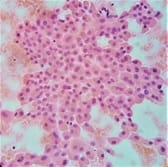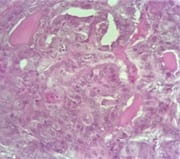Clinical and cytological spectrum of thyroid lesions and the role of fine needle aspiration cytology in its diagnosis at a tertiary care hospital
Akshatha N.1, Patil S.2*, P Bommanahalli B.3
DOI: https://doi.org/10.17511/jopm.2019.i08.03
1 Akshatha N, Assistant Professor, Department of Pathology, Gadag Institute of Medical Sciences, Gadag, Karnataka, India.
2* Shwetha Patil, Post MD Tutor, Department of Pathology, Gadag Institute of Medical Sciences, Gadag, Karnataka, India.
3 Basavaraj P Bommanahalli, Professor and Head, Department of Pathology, Gadag Institute of Medical Sciences, Gadag, Karnataka, India.
Background: Thyroid lesions are one of the significant clinical problems encountered in most of patients coming to the tertiary care units. Fine Needle Aspiration Cytology (FNAC) is the present day’s worldwide accepted diagnostic tool as it is a cost effective, minimally invasive, low complication, non-operative method and has a high sensitivity and specificity in most of thyroid lesions. Fine Needle Aspiration Cytology can be used in the diagnosis of these lesions and hence categorising them into benign / inflammatory / neoplastic and aiding the clinician in the next step of surgical / medical management and reduces the unwanted surgeries. Aim: To study the clinical and cytological spectrum of thyroid lesions encountered in everyday practice. Materials and Methods: This was a retrospective study conducted over the period of 1 year and 1 month, from January 2018 to January 2019 in department of pathology Gadag Institute Medical Science, Gadag. A total of 101 Patients with thyroid lesions who underwent Fine Needle Aspiration procedure were identified and their clinical details, available biochemical and radiological parameters were collected, and cyto-morphological features were studied. The lesions were categorised into benign, inflammatory, Follicular neoplasm, malignant and inadequate. Results: Out of 101 cases studied, 47 (46.5%) were Benign, 33 (32.6%) were Inflammatory,09 (8.9%) cases were Follicular Neoplasm and 04 (3.9%) cases were Malignant while 09 (8.9%) cases were inadequate. Conclusions: FNAC is one of the simple useful primary diagnostic tool for the identification and categorization of thyroid lesions. It is safe, cost-effective, minimally invasive and sensitive technique for its diagnosis.
Keywords: Fine needle aspiration cytology, Thyroid nodule, Thyroiditis fnac
| Corresponding Author | How to Cite this Article | To Browse |
|---|---|---|
| , Post MD Tutor, Department of Pathology, Gadag Institute of Medical Sciences, Gadag, Karnataka, India. Email: |
Akshatha N, Shwetha Patil, Basavaraj P Bommanahalli, Clinical and cytological spectrum of thyroid lesions and the role of fine needle aspiration cytology in its diagnosis at a tertiary care hospital. Trop J Pathol Microbiol. 2019;5(8):523-528. Available From https://pathology.medresearch.in/index.php/jopm/article/view/299 |


 ©
© 
